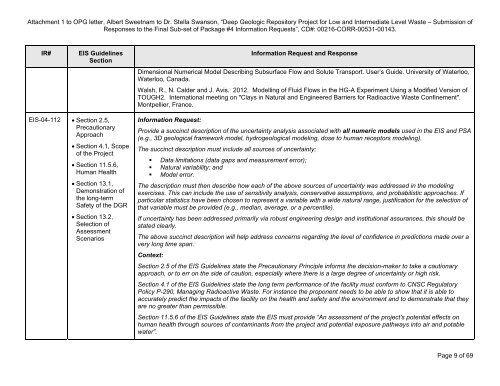Ontario Power Generation's Response to the Joint Review
Ontario Power Generation's Response to the Joint Review
Ontario Power Generation's Response to the Joint Review
Create successful ePaper yourself
Turn your PDF publications into a flip-book with our unique Google optimized e-Paper software.
Attachment 1 <strong>to</strong> OPG letter, Albert Sweetnam <strong>to</strong> Dr. Stella Swanson, “Deep Geologic Reposi<strong>to</strong>ry Project for Low and Intermediate Level Waste – Submission of<br />
<strong>Response</strong>s <strong>to</strong> <strong>the</strong> Final Sub-set of Package #4 Information Requests”, CD#: 00216-CORR-00531-00143.<br />
IR# EIS Guidelines<br />
Section<br />
EIS-04-112 � Section 2.5,<br />
Precautionary<br />
Approach<br />
� Section 4.1, Scope<br />
of <strong>the</strong> Project<br />
� Section 11.5.6,<br />
Human Health<br />
� Section 13.1,<br />
Demonstration of<br />
<strong>the</strong> long-term<br />
Safety of <strong>the</strong> DGR<br />
� Section 13.2,<br />
Selection of<br />
Assessment<br />
Scenarios<br />
Information Request and <strong>Response</strong><br />
Dimensional Numerical Model Describing Subsurface Flow and Solute Transport. User’s Guide. University of Waterloo,<br />
Waterloo, Canada.<br />
Walsh, R., N. Calder and J. Avis. 2012. Modelling of Fluid Flows in <strong>the</strong> HG-A Experiment Using a Modified Version of<br />
TOUGH2. International meeting on "Clays in Natural and Engineered Barriers for Radioactive Waste Confinement".<br />
Montpellier, France.<br />
Information Request:<br />
Provide a succinct description of <strong>the</strong> uncertainty analysis associated with all numeric models used in <strong>the</strong> EIS and PSA<br />
(e.g., 3D geological framework model, hydrogeological modeling, dose <strong>to</strong> human recep<strong>to</strong>rs modeling).<br />
The succinct description must include all sources of uncertainty:<br />
� Data limitations (data gaps and measurement error);<br />
� Natural variability; and<br />
� Model error.<br />
The description must <strong>the</strong>n describe how each of <strong>the</strong> above sources of uncertainty was addressed in <strong>the</strong> modeling<br />
exercises. This can include <strong>the</strong> use of sensitivity analysis, conservative assumptions, and probabilistic approaches. If<br />
particular statistics have been chosen <strong>to</strong> represent a variable with a wide natural range, justification for <strong>the</strong> selection of<br />
that variable must be provided (e.g., median, average, or a percentile).<br />
If uncertainty has been addressed primarily via robust engineering design and institutional assurances, this should be<br />
stated clearly.<br />
The above succinct description will help address concerns regarding <strong>the</strong> level of confidence in predictions made over a<br />
very long time span.<br />
Context:<br />
Section 2.5 of <strong>the</strong> EIS Guidelines state <strong>the</strong> Precautionary Principle informs <strong>the</strong> decision-maker <strong>to</strong> take a cautionary<br />
approach, or <strong>to</strong> err on <strong>the</strong> side of caution, especially where <strong>the</strong>re is a large degree of uncertainty or high risk.<br />
Section 4.1 of <strong>the</strong> EIS Guidelines state <strong>the</strong> long term performance of <strong>the</strong> facility must conform <strong>to</strong> CNSC Regula<strong>to</strong>ry<br />
Policy P-290, Managing Radioactive Waste. For instance <strong>the</strong> proponent needs <strong>to</strong> be able <strong>to</strong> show that it is able <strong>to</strong><br />
accurately predict <strong>the</strong> impacts of <strong>the</strong> facility on <strong>the</strong> health and safety and <strong>the</strong> environment and <strong>to</strong> demonstrate that <strong>the</strong>y<br />
are no greater than permissible.<br />
Section 11.5.6 of <strong>the</strong> EIS Guidelines state <strong>the</strong> EIS must provide “An assessment of <strong>the</strong> project's potential effects on<br />
human health through sources of contaminants from <strong>the</strong> project and potential exposure pathways in<strong>to</strong> air and potable<br />
water”.<br />
Page 9 of 69
















